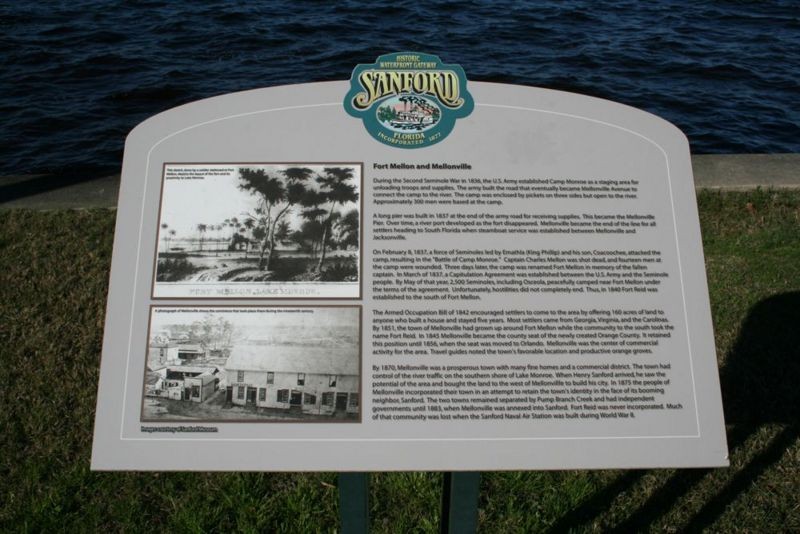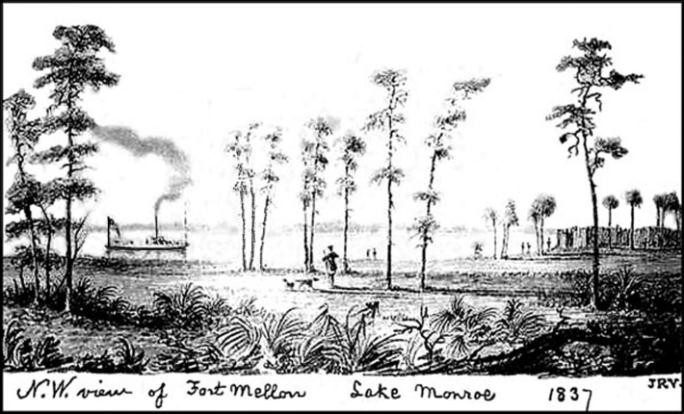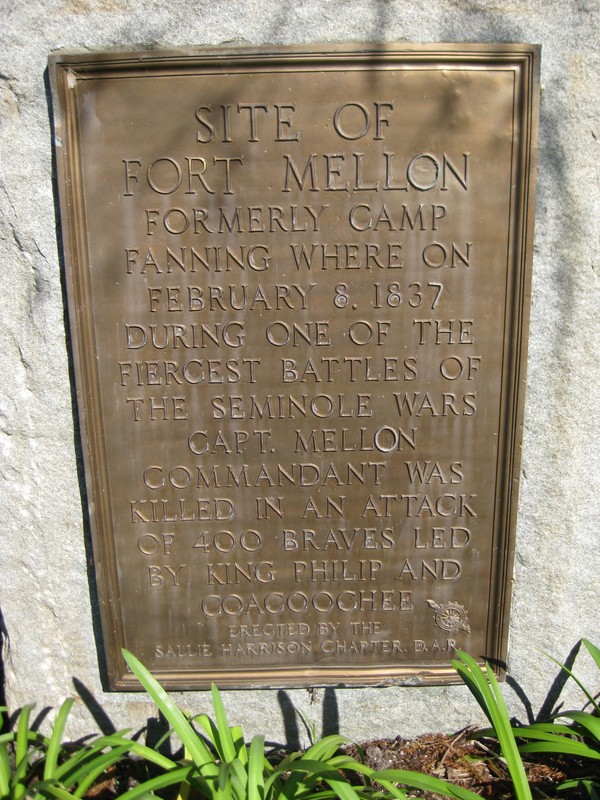Fort Mellon Historical Site (Camp Monroe)
Introduction
Text-to-speech Audio
Images
Official Sanford Historic Plaque and Description on location

Original sketch of Camp Monroe 1837

Plaque in remembrance of the battle at Camp Monroe

Backstory and Context
Text-to-speech Audio
Fort Mellon, previously known as Camp Monroe, shaped and influenced its surrounding areas more than many people may know. The Fort was erected in 1836 as Camp Monroe as a staging area for troops and supplies during the Second Seminole war. Many troops of the United States army have been pushing further and further south into heavily populated Seminole Indian territory. The fort was strategically placed on the shore of Lake Monroe which stretches sixteen miles and flows into the St. Johns River. The area was home to around two hundred and fifty Seminole under the leadership of chief Coacoochee (Wildcat) who proclaimed that he was “made from the sands of Florida”. In order to win back control of their beloved “Wepolokse” (round lake), the chief and his large tribe faced many well trained military men. Some notable military figures that were at Camp Monroe/Fort Mellon include generals Jesup, Hernandez and Eustis with colonels Harney, Twiggs, and Fanning, many in which local towns or lakes have been named after.
The Second Seminole was caused by the further expulsion of Seminole tribes executed by Andrew Jackson who as president, extracted many Native tribes from Florida already. As the Seminole tribe numbers dwindled and they faced losing more land than they already have, they had the choice to leave or fight for their land and rights. The Seminoles decided to fight.
Right before daybreak on February 8th, 1837, Seminoles led by chief Emathla and his son Coacoochee attacked the sleeping barracks of Fort Mellon where tents of the sleeping soldiers were easy targets with rifles. The men slept with their weapons and quickly were ready and began firing back at the Seminoles. Luckily for the men at the fort, the day before they were ordered to construct a wall with large pine logs which helped that morning and the Seminoles could not invade the fort itself. Col. Fanning and his men then used a steamboat and its artillery to take shots on the invading Seminoles which served as a pivotal moment in the battle where it showed how their modern military resources had great advantage over the desperate and lacking Seminole.
The Seminoles retreated to the Oklawaha river and as they regrouped in anticipation to return to battle, a messenger from the head chief of the Seminole Miconopy informed them of the Armistice or Capitulation negotiation. The only fallen soldier at Camp Monroe was Captain Mellon of the Second Regiment of Artillery. The men at Camp Monroe were given the order to retreat to Fort Call and Fanning sent a letter to General Jesup to give news of the battle and the sole loss of Captain Mellon.“Capt. Mellon served during the last war against the Great Britain. On this spot he gave his life to his country. Honor to his memory! Henceforth, the strong picket work constructed here by your labor, will be called Fort Mellon.” – Colonel Fanning.
The implication of everything that happened at Fort Mellon has shaped local history drastically. The military that occupied the camp shaped the area around it by creating different roads and even created the surrounding town of Mellonville. Some soldiers explored the area thoroughly, drawing detailed maps and writing about the local fauna. Lake Monroe was a strategic place for the fort but little did they know, the area surrounding them would later become downtown Sanford, one of the busiest and notable parts of the city. Though the Second Seminole war was not something to celebrate, without Fort Mellon, Sanford would not be the same.
Sources
1. Fort Mellon 1837-42 A microcosm of the Second Seminole war. Arthur E. Francke, jr.
2. Title Marker - Historic Markers Across Florida. N.p., n.d. Web. 26 Apr. 2017
3. "Second Seminole War." Encyclopædia Britannica. Encyclopædia Britannica, Inc., n.d. Web. 26 Apr. 2017
